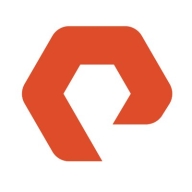


Nutanix Cloud Infrastructure and Red Hat Ceph Storage compete in the cloud infrastructure space. Nutanix seems to have the upper hand with its comprehensive solution offering impactful features and recognized customer service.
Features: Nutanix Cloud Infrastructure stands out with its high-performance I/O, high availability, ease of administration, and monitoring capabilities through Prism. It also provides hyper-convergence, ease of scalability, shadow cloning, deduplication, and automation. Red Hat Ceph Storage is valued for its adaptability across hardware types, robust integration with Red Hat products, distributed architecture, data protection, and storage auto-tiering.
Room for Improvement: Nutanix should enhance integration with external storage, improve advanced networking capabilities, and create a more competitive pricing model. Red Hat Ceph Storage could benefit from easier setup, a better management interface, and optimized performance during storage rebalancing and recovery.
Ease of Deployment and Customer Service: Nutanix is praised for its adaptability across on-premises, hybrid, and private cloud environments, with easy implementation and responsive technical support. Red Hat Ceph Storage also supports various deployments but may require more technical expertise for setup, though its support is considered excellent.
Pricing and ROI: Nutanix is often seen as pricey but delivers a strong ROI due to its scalable solution that reduces hardware and operational costs over time. Red Hat Ceph Storage offers a more economical alternative, leveraging its open-source roots. Nutanix requires a higher initial outlay, while Red Hat's subscription options present a more flexible licensing model.
| Product | Market Share (%) |
|---|---|
| Red Hat Ceph Storage | 14.3% |
| Nutanix Cloud Infrastructure (NCI) | 5.7% |
| Pure Storage FlashBlade | 3.3% |
| Other | 76.7% |


| Company Size | Count |
|---|---|
| Small Business | 11 |
| Midsize Enterprise | 11 |
| Large Enterprise | 21 |
| Company Size | Count |
|---|---|
| Small Business | 91 |
| Midsize Enterprise | 77 |
| Large Enterprise | 82 |
| Company Size | Count |
|---|---|
| Small Business | 13 |
| Midsize Enterprise | 4 |
| Large Enterprise | 15 |
FlashBlade is the industry’s most advanced scale-out storage for unstructured data, powered by a modern, massively parallel architecture to consolidate complex data silos (like backup appliances and data lakes) and accelerate tomorrow’s discoveries and insights.
Nutanix Cloud Infrastructure (NCI) is a top-ranking HCI software, cloud management tool, and Software Defined Storage (SDS) tool that is marketed as the foundation for users' hybrid clouds. It offers a powerful and secure hyperconverged infrastructure to deliver all data and applications at any scale and on any cloud. The solution offers a complete software stack that allows users to unify their hybrid cloud infrastructure.
NCI’s services include computer, storage and network, hypervisors and containers, and deployment in public or in private clouds. The product also comes with built-in resilience, disaster recovery capabilities, self-healing, and high-security capacities. It provides further deployment flexibility through several software and hardware options and platforms. NCI includes a full set of enterprise capabilities. It can also be deployed on a wide range of servers from popular manufacturers.
The capabilities of the product are categorized into three main groups:
Outside of these categories, NCI also offers other capabilities:
Nutanix Cloud Infrastructure (NCI) Features
Nutanix Cloud Infrastructure (NCI) offers its customers various features and tools in each of the previously mentioned categories. The available features for users currently include:
Nutanix Cloud Infrastructure (NCI) Benefits
The product offers various benefits to users who utilize its capacities. Some of these include:
Reviews from Real Users
According to Gerhard J., an IT manager at Q4 Fuel, Nutanix Cloud Infrastructure (NCI) provides serious reliability and stability across the entire system makes for ROI.
A solutions architect at a computer software company describes NCI as a stable, straightforward to set up, and scalable solution.
We monitor all Software Defined Storage (SDS) reviews to prevent fraudulent reviews and keep review quality high. We do not post reviews by company employees or direct competitors. We validate each review for authenticity via cross-reference with LinkedIn, and personal follow-up with the reviewer when necessary.